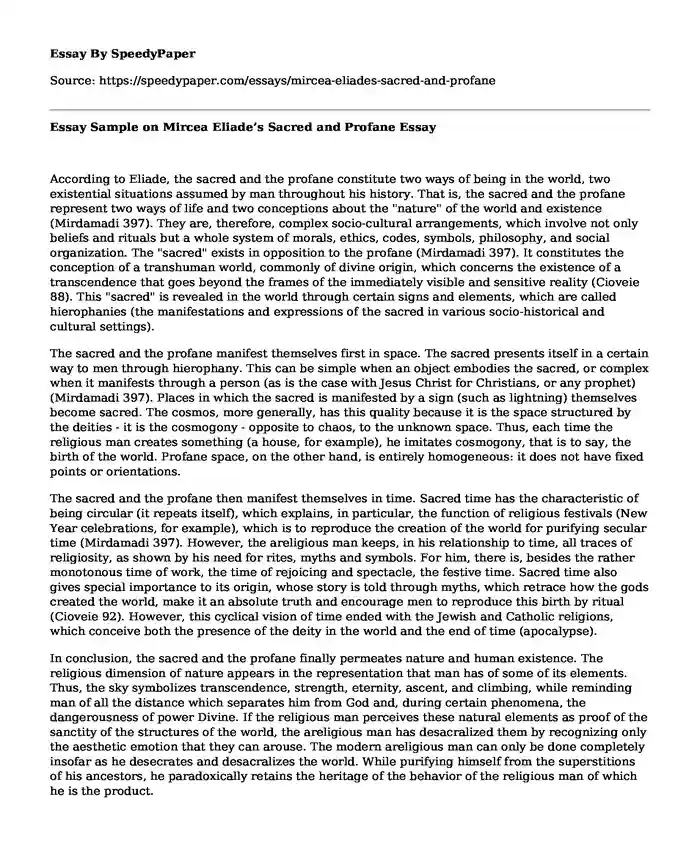
| Essay type: | Rhetorical analysis essays |
| Categories: | Philosophy Christianity Human behavior |
| Pages: | 3 |
| Wordcount: | 640 words |
According to Eliade, the sacred and the profane constitute two ways of being in the world, two existential situations assumed by man throughout his history. That is, the sacred and the profane represent two ways of life and two conceptions about the "nature" of the world and existence (Mirdamadi 397). They are, therefore, complex socio-cultural arrangements, which involve not only beliefs and rituals but a whole system of morals, ethics, codes, symbols, philosophy, and social organization. The "sacred" exists in opposition to the profane (Mirdamadi 397). It constitutes the conception of a transhuman world, commonly of divine origin, which concerns the existence of a transcendence that goes beyond the frames of the immediately visible and sensitive reality (Cioveie 88). This "sacred" is revealed in the world through certain signs and elements, which are called hierophanies (the manifestations and expressions of the sacred in various socio-historical and cultural settings).
The sacred and the profane manifest themselves first in space. The sacred presents itself in a certain way to men through hierophany. This can be simple when an object embodies the sacred, or complex when it manifests through a person (as is the case with Jesus Christ for Christians, or any prophet) (Mirdamadi 397). Places in which the sacred is manifested by a sign (such as lightning) themselves become sacred. The cosmos, more generally, has this quality because it is the space structured by the deities - it is the cosmogony - opposite to chaos, to the unknown space. Thus, each time the religious man creates something (a house, for example), he imitates cosmogony, that is to say, the birth of the world. Profane space, on the other hand, is entirely homogeneous: it does not have fixed points or orientations.
The sacred and the profane then manifest themselves in time. Sacred time has the characteristic of being circular (it repeats itself), which explains, in particular, the function of religious festivals (New Year celebrations, for example), which is to reproduce the creation of the world for purifying secular time (Mirdamadi 397). However, the areligious man keeps, in his relationship to time, all traces of religiosity, as shown by his need for rites, myths and symbols. For him, there is, besides the rather monotonous time of work, the time of rejoicing and spectacle, the festive time. Sacred time also gives special importance to its origin, whose story is told through myths, which retrace how the gods created the world, make it an absolute truth and encourage men to reproduce this birth by ritual (Cioveie 92). However, this cyclical vision of time ended with the Jewish and Catholic religions, which conceive both the presence of the deity in the world and the end of time (apocalypse).
In conclusion, the sacred and the profane finally permeates nature and human existence. The religious dimension of nature appears in the representation that man has of some of its elements. Thus, the sky symbolizes transcendence, strength, eternity, ascent, and climbing, while reminding man of all the distance which separates him from God and, during certain phenomena, the dangerousness of power Divine. If the religious man perceives these natural elements as proof of the sanctity of the structures of the world, the areligious man has desacralized them by recognizing only the aesthetic emotion that they can arouse. The modern areligious man can only be done completely insofar as he desecrates and desacralizes the world. While purifying himself from the superstitions of his ancestors, he paradoxically retains the heritage of the behavior of the religious man of which he is the product.
Works Cited
Cioveie, Valentin. "„The Transcendental Structure of the Archaic Universe. Mircea Eliade’s The Sacred and the Profane”." Annals of the University of Bucharest. Philosophy Series 64.1 (2015): 83-112. https://pdfs.semanticscholar.org/d3ed/949b42856b92671c60a863c616f3ab048a15.pdf
Mirdamadi, Yaser. "The Plurality of the Sacred—Critical Remarks on Mircea Eliade’s Conception of the Sacred." Open Journal of Philosophy 5.07 (2015): 397. http://www.scirp.org/journal/PaperInformation.aspx?PaperID=61087&#abstract
Cite this page
Essay Sample on Mircea Eliade's Sacred and Profane. (2023, Aug 10). Retrieved from https://speedypaper.net/essays/mircea-eliades-sacred-and-profane
Request Removal
If you are the original author of this essay and no longer wish to have it published on the SpeedyPaper website, please click below to request its removal:
- Free Essay: Philosophers' Opinions on Reality and Existence of Knowledge
- Organizational Behavior Assignment, Free Essay Sample for Students
- Prejudice: Negative Evaluation of Others Based on Group Membership. Essay Example
- Essay Sample on the Concept of God in a Community
- Paper Example: Performance Improvement Program Evaluation Logic Model
- Free Essay. My Consumer Choice
- Paper Example. Discussion Response to Angie's Post
Popular categories




